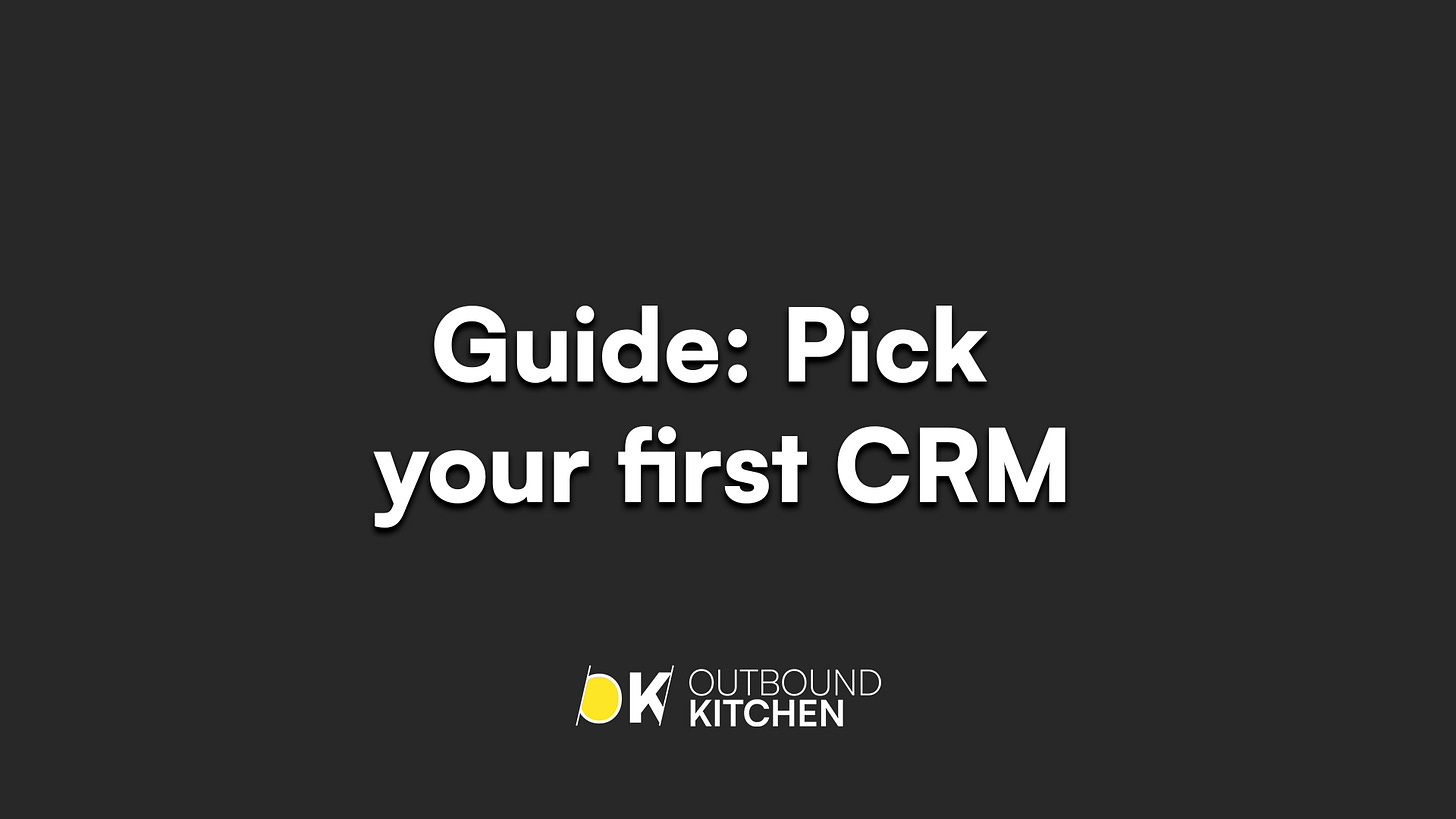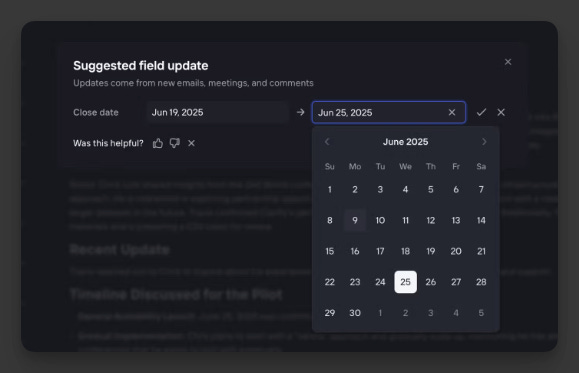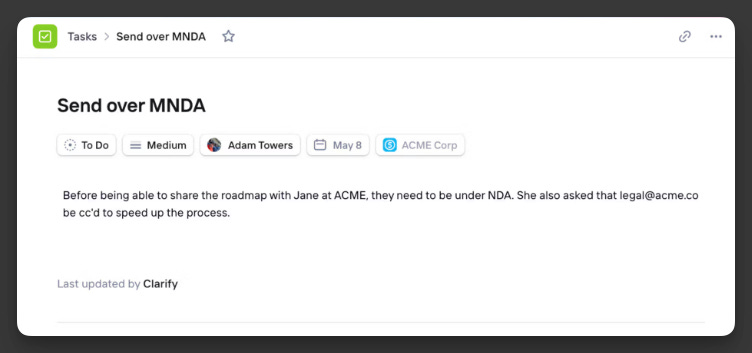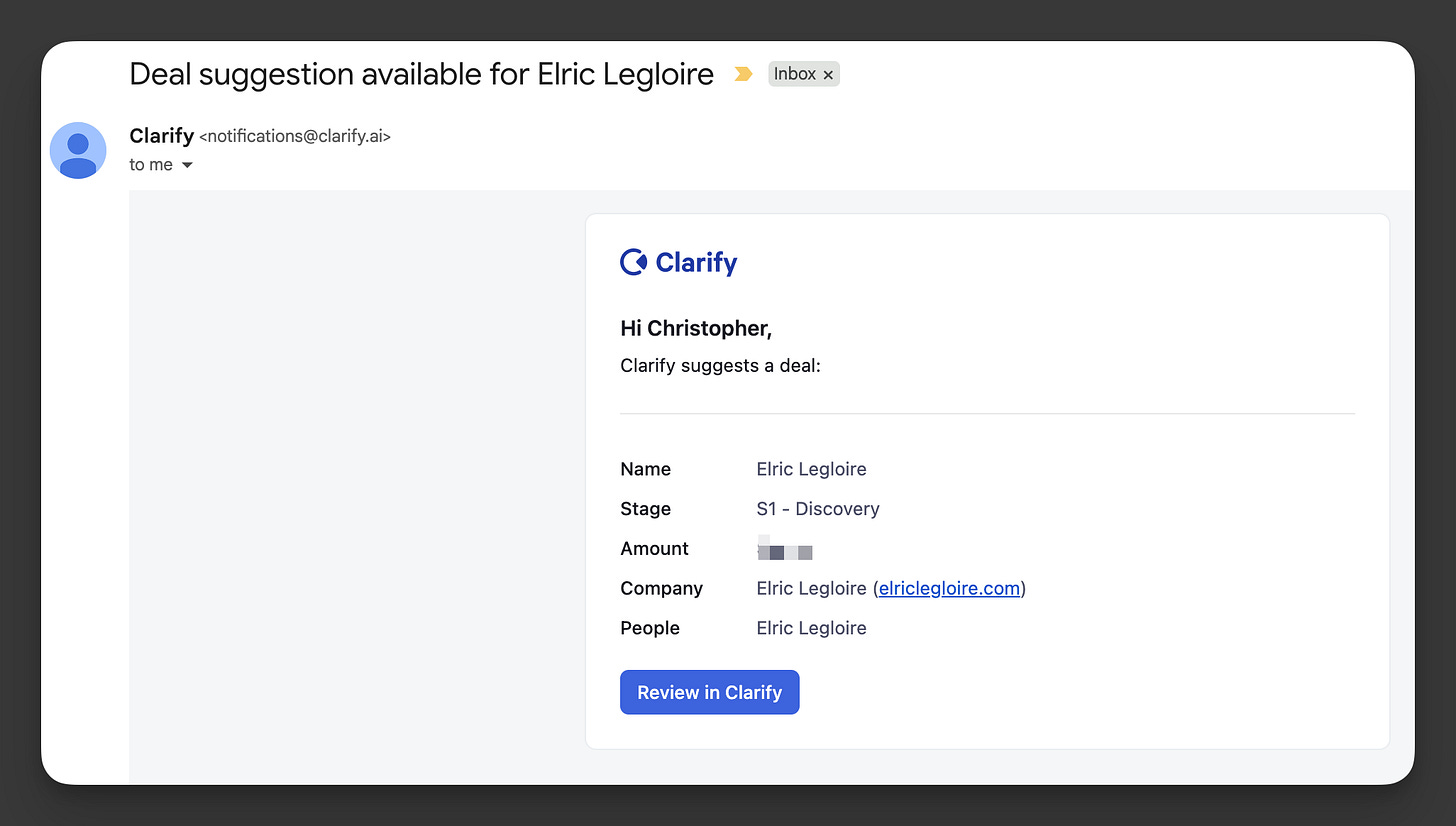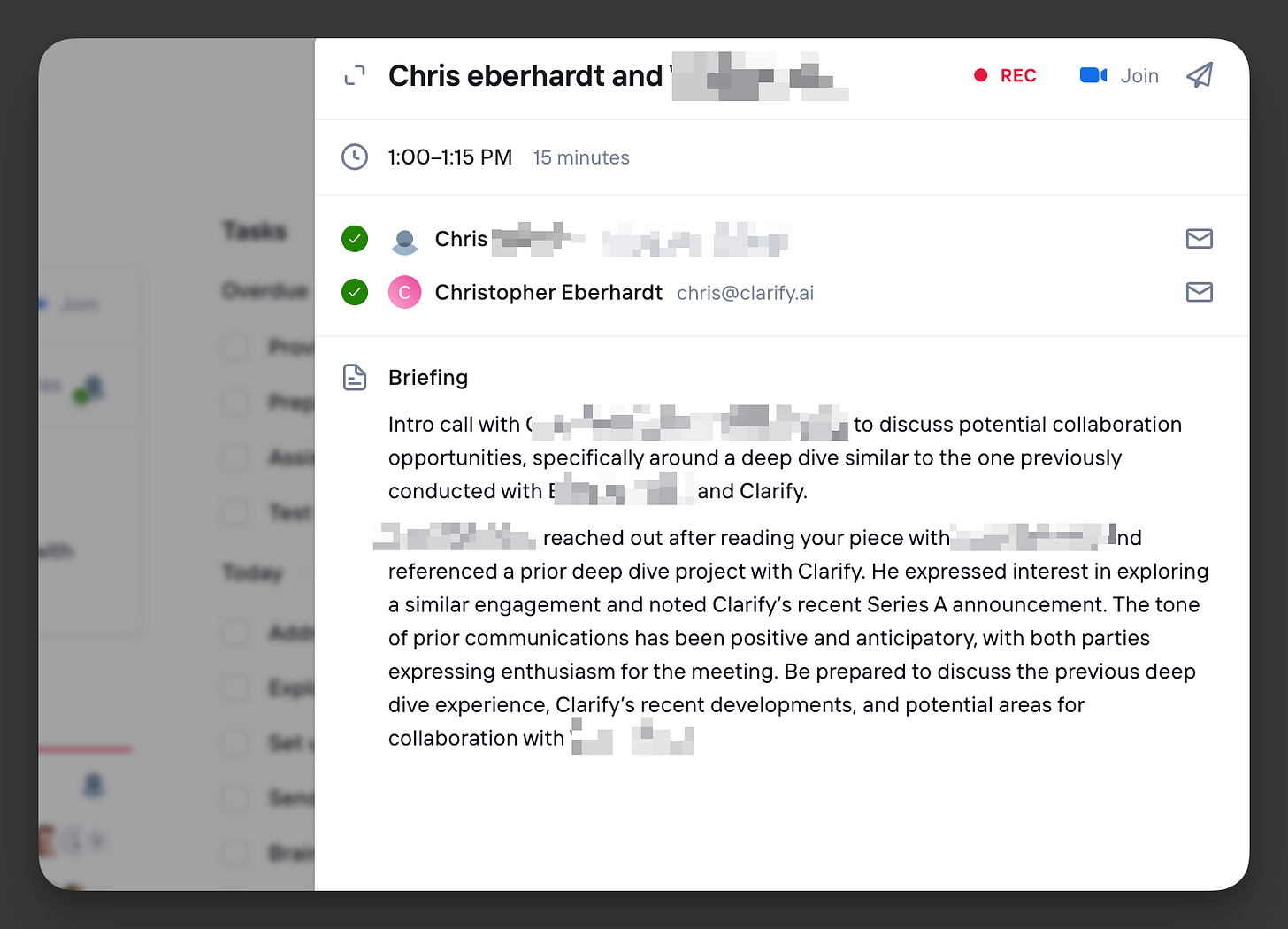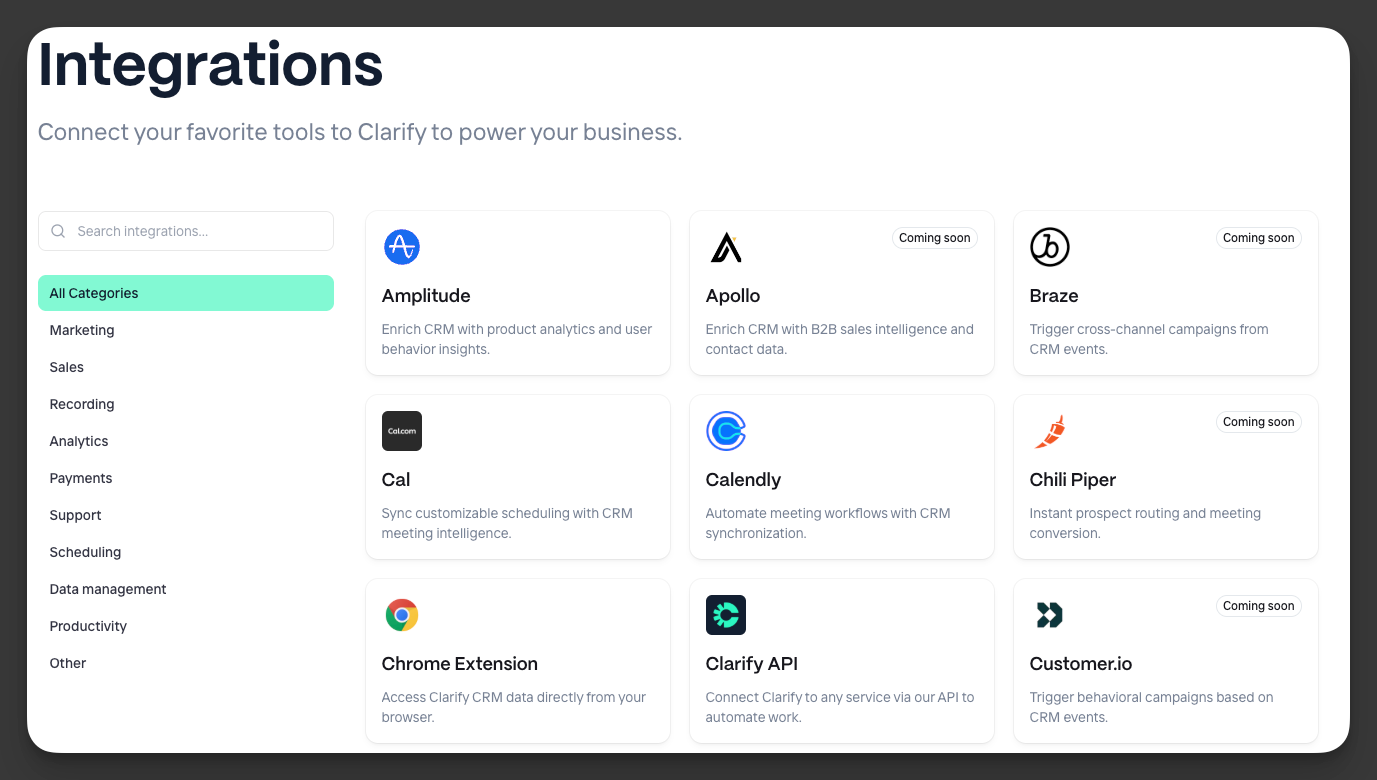How to Pick a CRM Your Outbound Reps Will Love
The early-stage guide
Full transparency:
Clarify sponsored this deep dive, but these principles work regardless of which CRM you end up choosing.
One of the biggest reasons outbound teams underperform?
They're drowning in non-revenue-generating activities.
One of the reasons?
CRMs.
Because most CRMs are built for VPs, not reps. Dashboards over daily work. Reports over revenue. Admin tasks over actual selling.
But in early-stage companies, this hurts even more.
Every hour updating fields or switching between tools is an hour not talking to prospects.
Everyone's consolidating their tech stack, but their CRM is actually creating more work, not less.
Let's calculate the cost:
One Full-Cycle AE spending 30% of time on CRM admin at $130k OTE = $39,000/year in lost selling time
For a 5-person team? That's $195,000 annually burned on data entry.
The irony: the CRM was meant to boost sales and is actually doing the opposite:
killing productivity.
That's why a new kind of CRM is emerging: autonomous, AI-powered, rep-centric CRMs like Clarify.
No sales ops required. No constant maintenance. Just revenue-generating activities.
This isn't about consolidating tools, it's about putting revenue first by putting reps first.
The best outbound teams are already building these rep-centric stacks, and that's exactly what we're diving into today:
How to pick your first CRM Your Outbound Reps Will Love.
I'm excited to dig into this topic with you today.
Note for founders without reps yet:
You're the rep right now. Everything below applies to you, and it's even more important to build the right stack early.
Here’s what's on the menu:
Why Traditional CRMs Kill Outbound Team Productivity
The Rep-First CRM Evaluation Framework
Non-Negotiable Features for Rep-Centric CRMs
The Implementation Reality Check
Making the Case: How to Champion a Rep-First CRM
The Future is Autonomous (& Rep-centric)
Let's start with why reps hate their CRMs:
1. Why traditional CRMs are killing your outbound team
Traditional CRMs were built in 2005 for a 2005 sales motion: inbound leads, inside sales, predictable pipelines. Built for reporting up, not executing out.
But outbound in 2025? It's a different beast entirely.
The "Admin Prison" Problem
Picture your best rep crushing a call. Prospect interested, follow up booked. They're fired up for the next dial. But first? The 12-minute CRM tax:
Log the call
Log the opportunity
Update 15 fields to move your opp to the next stage
Create tasks
Update the contact and opportunity
Write and send follow-up
By the time they're done, momentum = dead.
Every hour on admin = lost pipeline & revenue opportunity.
The Hygiene Nightmare
I once had a manager, ex-Salesforce, who was obsessed with CRM hygiene. Every meeting, every check-in: "The CRM needs to be perfect. Keep it clean."
Here's the problem:
Our CRM was already a mess when my 5-person team got it. Years of bad data, duplicate accounts, and empty fields. But somehow, we had to sell AND fix this mess.
We tried everything, cleaning it by hand, using tools, bulk updates. He was never happy.
The truth about old CRMs:
Reps skip fields to save time
Data goes stale in days
Duplicate records multiply like rabbits
Nobody trusts what's in there
Here's how it falls apart:
Week 1: Reps skip fields to save time
Week 4: Boss makes MORE fields required
Week 8: Reps find shortcuts (spreadsheets, notes, just remembering)
Month 6: Managers say "Don't check the CRM, just ask the rep"
Month 12: Your "source of truth" is full of garbage data
When your CRM needs constant cleaning just to work, you don't have a hygiene problem, you have a system problem. And bothering your reps won't fix it.
You can call it your "source of truth" all you want. But if the data doesn’t live there? You’re just scaling your technical debt.
Why It's 10x Worse for Early-Stage Teams
Bigger companies have RevOps teams managing Salesforce.
You have... maybe someone who "knows databases."
The impact:
Full-Cycle AEs: 10 cold calls/day
You need: 50-60 calls/day
Every hour on admin = 20 lost dials
That's 80-100 fewer conversations monthly.
Not just numbers, that's runway burning.
Red Flags Your CRM Is Rep-Hostile:
🚩 10+ fields to fill after each call
🚩 Multiple screens for one task (the "where's Waldo" UX)
🚩 "Training required" for basics (the "it's not you, it's us" flag)
🚩 No API or integrations (the "data island" problem)
🚩 Demos focus on dashboards, not daily use (the "built for bosses" tell)
The good news?
You can avoid this entire mess.
But you need a different system, a CRM built for reps, not reports.
2. The Rep-First CRM Evaluation Framework
Before you even Google "best CRM for startups," stop.
You need a system to evaluate what you need for your stage.
Phase 1: The Reality Audit (Not the Demo)
Shadow your best rep for one day (or take notes of your day-to-day). Measure everything:
The Click Counter: How many clicks for each CRM task?
Log a call: __ clicks
Find prospect info: __ clicks
Update opportunity: __ clicks
Schedule follow-up: __ clicks
The Time Tracker: Use a stopwatch for each CRM interaction
If any task takes >30 seconds, it's friction
If any task takes >3 clicks, it's friction
The Automation Opportunity Map For each task, ask: "Could AI do this instead?"
Extract insights from your conversations and update your CRM? (Clarify does this automatically)
Enriching contacts? ✓ (Clarify auto-enriches from emails)
Creating follow-ups? ✓ (Clarify generates from conversation context)
Phase 2: Surface the Hidden Friction
Run a 30-minute "Rep Council" with three questions:
"Show me your actual workflow" (not what's in the manual)
"What makes you want to throw your laptop?"
"If you could wave a magic wand, what would the CRM do?"
Create a 2-minute survey scoring friction (1-5) for each workflow.
The reality:
Most teams discover 60-80% of CRM time is pure waste.
Phase 3: Build Your Non-Negotiables List
Based on your audit, create three columns:
Must Have (deal breakers)
Nice to Have (tie breakers)
Don't Care (vendor fodder)
For early-stage outbound teams, your "Must Have" should include everything in the next section, so they spend most of their time prospecting or in sales calls.
3. The Non-Negotiables That Separate Rep-First from Rep-Hostile CRMs
These features didn't exist 3 years ago. Today they're mandatory.
This isn't a wishlist, these are the features that separate modern CRMs from the legacy nightmares still torturing sales teams.
1. Autonomous Data Capture (The Game Changer)
Your CRM should handle this stuff automatically:
AI that logs calls, emails, meetings automatically and transcribe (Clarify's ambient intelligence captures everything)
Calls logged automatically with AI transcription
Fields automatically updated
Opportunities created automatically
Tasks created automatically
Emails captured without forwarding or BCCing
Meetings recorded and summarized without clicking "record"
Contacts created and enriched from signatures
Write and send follow-up emails (coming soon on Clarify)
Here's how something like Clarify works:
rep sends an email, and the system automatically creates the contact, enriches it with company data, logs the activity, creates relevant tasks, and sets follow-up reminders. Zero clicks from the rep
2. Automatic Hygiene Maintenance
The system should clean up after itself:
AI prevents duplicate records
Auto-merges similar contacts
Updates stale data continuously
Validates information in real-time
Suggests and updates deals from conversations
No more "data cleanup Fridays." The CRM maintains itself like a good assistant should.
3. Instant Context
Before every call, reps should see everything in one view:
All past interactions (emails, calls, meetings)
Key insights and talking points
Suggested next steps
Product usage data (if applicable)
No searching across tabs. No scrolling through endless activity feeds. Just instant context when they need it.
4. Workflow That Matches How Reps Actually Work
Look for systems that actually work like reps work:
Smart templates that adapt
Bulk actions that work
Connects to your whole stack The best CRMs integrate with your entire outbound stack.
Trigger specific workflows directly from your CRM: website visits, product events, closed lost opportunities
Modern CRMs like Clarify connect with your whole outbound stack: Apollo (Soon), Outreach (Soon), plus 7,000+ tools via Zapier and API.
Now you understand what to look for.
But even the perfect CRM can fail if implementation goes wrong.
Here's how to nail it:
4. The Implementation Reality Check
Let's talk about what CRM implementation actually looks like.
Spoiler: it's usually painful.
Why "Easy Setup" Is Usually BS
Vendors love saying "quick setup" then dump a 200-page manual on your desk. Salesforce implementations average 6-12 months and cost $50K+. You'll need training just to figure out where they hid your leads and reports.
Compare that to something like Clarify: users report being productive within hours. Connect your email, install the Chrome extension, start selling. That's it.
"Deployed" vs "Actually Used": There's a Huge Difference
Deployment: Your CRM is technically live Adoption: Your reps actually use it
Most CRMs nail deployment but fail with adoption.
Setting Realistic Timelines for Rep Productivity
Day 1-7: Basic usage and data flowing
Week 2-4: Workflow optimization
Month 2: Full productivity gains realized
The Make-or-Break First 30 Days
These three things are non-negotiable:
Reps see immediate time savings (automation actually works)
Zero additional admin work gets dumped on them
Quick visible wins (better data quality, faster follow-ups, cleaner pipeline)
When to Cut Your Losses
If your reps are building elaborate workarounds by week 4, kill it. Don't fall for the sunk cost fallacy—it's killed more sales teams' productivity than bad hiring.
Once you've found the right CRM and planned a realistic rollout, there's still one final hurdle: getting everyone who matters to actually approve the budget...
5. Building the Business Case That Gets Instant Buy-In
You've found the perfect rep-first CRM. Now you need to get past the "sounds expensive" reflex.
Skip the fancy ROI projections. Use this simple model:
Current State:
Rep salary: $100K
Time on CRM admin: 30% = $30K/year
5 reps = $150K annual waste
After Switching to AI-Powered CRM:
Admin time reduced 80%
Time returned: 24% of capacity
Value: $120K in selling time returned
New revenue from increased capacity: $500K-1M
Break-even: 6-8 weeks (vs 12+ months for traditional CRMs)
The CFO Conversation
Don't overcomplicate it. Show them this:
Traditional CRM: $125/user/month + $50K implementation + months of lost productivity
Modern autonomous CRM: Credit-based pricing (you pay for actual work done) + immediate gains
SMost autonomous CRMs pay for themselves in 2-3 months. Traditional ones? You're lucky if you break even in a year.
Getting Leadership to Say Yes
Frame it as competitive advantage:
"While our competitors' reps are stuck doing data entry, ours are having 20% more actual sales conversations."
The Pilot That Proves Everything
Start with your top 2 performers (they'll maximize results)
Set clear metrics:
Dials per day
Pipeline created
Time saved (self-reported)
Data quality scores
Run for 30 days
Let results speak: "Our pilot team booked 40% more meetings"
The evidence becomes undeniable. The path forward becomes obvious.
Which brings us to the future that's already here:
6. The Future CRM is Autonomous (& Rep-centric)
We're watching sales tech completely flip on its head right now.
And honestly? It's about time.
This isn't just about picking shinier software, it's about ditching a fundamentally broken approach to sales productivity.
The Old Paradigm: Reps as data clerks
30% of time on manual entry
CRM as a necessary evil
Technology that slows selling
The New Reality: AI & tech as your data assistant
95% of data captured automatically
CRM as a competitive advantage
Technology that accelerates selling
Autonomous CRMs like Clarify are what this looks like in practice. Instead of making reps fight the system, the system works for them. No more endless clicking through tabs. No more "did I update that opportunity?" panic. No more explaining to your manager why the data's wrong.
The ambient intelligence handles the busywork. The rep-first design keeps sellers actually selling. One platform instead of juggling five different tools. And you can get it running in hours, not months of implementation hell.
But here's what really matters:
While your competitors are still wrestling with Salesforce, your reps are having actual conversations. While they're cleaning data, you're closing deals. While they're fighting their tools, you're fighting for market share.
The math works. The approach is proven.
Ready to give your reps a CRM they'll actually love?
Try Clarify to see what happens when your CRM actually works for your team instead of against them.
Click here to try Clarify for free or book a demo to explore the future of autonomous CRM.
P.S. Personally, I'm always testing new tools that look promising, but honestly, I'm rarely impressed by the latest tech/AI hype.
CRMs were never on my radar until recently. The new generation of sales tools is actually rep-centric, and Clarify nailed it. I was juggling Folk for CRM and Fathom for meeting recording, but after trying Clarify, I'm slowly migrating everything over.
For a solo business like mine, it was honestly a no-brainer. I've already started pushing it to other early-stage teams because it just works better than the setup I had before.



